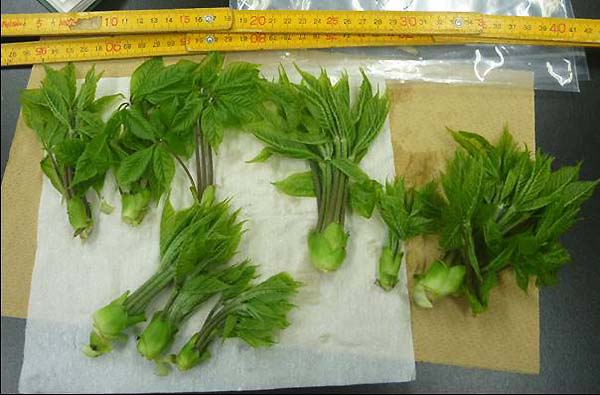Home > Research > Research Results > Research Results 2017 > Things you should be careful about while collecting edible wild plants from areas with radioactive cesium
Update:September 11, 2017
Main content starts here.
Things you should be careful about while collecting edible wild plants from areas with radioactive cesium
| Article title |
Radioactive materials in edible wild plants |
|---|---|
| Author (affiliation) |
Yoshiyuki Kiyono (a), Akio Akama (b) (a) Department of Plant Ecology, FFPRI, Tsukuba, Ibaraki, Japan. (b) Center for Forest Restoration and Radioecology, FFPRI, Tsukuba, Ibaraki, Japan. |
| Publication Journal |
Water Science, 355 ( vol.61(2) ): 36-50, June 2017 |
| Content introduction |
One of the consequences of the Tokyo Electric Power Company Fukushima Daiichi Nuclear Power Plant Station accident is the severe radioactive contamination of edible wild plants. Therefore, the shipping of edible wild plants in the market is subject to restrictions in all municipalities where high levels of contamination were detected. However, limited information is available for people who collect edible wild plants in terms of when and where to find such plants with minimal radioactive contamination. Therefore, we investigated the concentrations of radioactive cesium in over 40 edible wild plant species, including Petasites japonicus, Osmunda japonica, and Eleutherococcus sciadophylloides, mainly in Fukushima Prefecture since the spring of 2012. In addition, we quantitatively evaluated the ease of migration of radioactive cesium from the ecosystem into 12 edible wild plant species based on data released by Fukushima Prefecture over several years after the accident. Consequently, compared with other edible wild plant species, E. sciadophylloides was found to absorb a greater amount of radioactive cesium from its habitat and to have a property of absorbing more radioactive cesium as the concentrations of radioactive cesium in its habitat increases. Therefore, this species was identified as an edible wild plant species that can contain high concentrations of radioactive cesium. We, at the Forestry and Forest Products Research Institute, summarized reference information for people who collect edible wild plants ( e.g., species and habitat characteristics that tend to have high concentrations of radioactive cesium ), based on the results of a survey conducted in the spring of 2013 ( http://www.rinya.maff.go.jp/j/tokuyou/kinoko/sansai.html( External link ) ). The state of radioactive contamination of edible wild plants is continuously changing, and it is essential keep updating the information relate to this. The results from the present survey include data obtained after the spring of 2013, and we believe that they can be used to update the reference information.
Photo. Young shoots of Eleutherococcus sciadophylloides. |
Copyright © Forest Research and Management Organization. All rights reserved.

